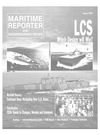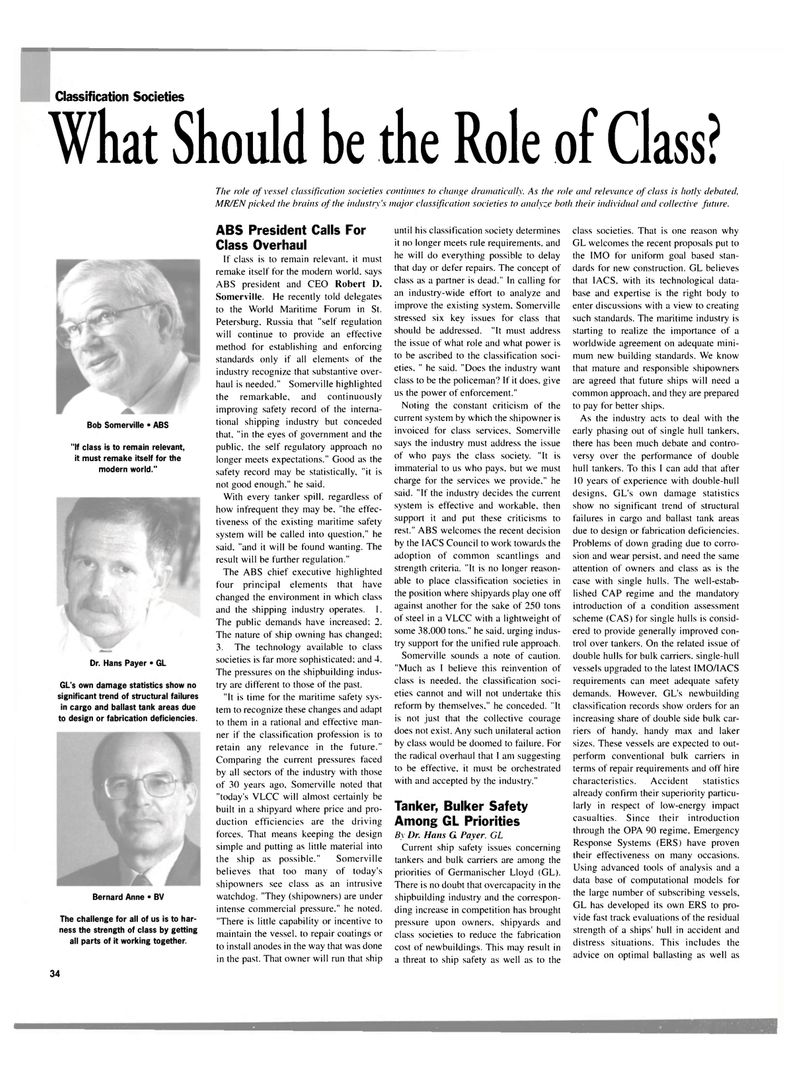
Page 34: of Maritime Reporter Magazine (August 2003)
Read this page in Pdf, Flash or Html5 edition of August 2003 Maritime Reporter Magazine
Classification Societies What Should be the Role of Class?
The role of vessel classification societies continues to change dramatically. As the role ancl relevance of class is liotly debated,
MR/EN picked the brains of the industry's major classification societies to analyze both their individual and collective future.
Bob Somerville • ABS "If class is to remain relevant, it must remake itself for the modern world."
Dr. Hans Payer • GL
GL's own damage statistics show no significant trend of structural failures in cargo and ballast tank areas due to design or fabrication deficiencies.
Bernard Anne • BV
The challenge for all of us is to har- ness the strength of class by getting all parts of it working together. 34
ABS President Calls For
Class Overhaul
If class is to remain relevant, it must remake itself for the modern world, says
ABS president and CEO Robert D.
Somerville. He recently told delegates to the World Maritime Forum in St.
Petersburg. Russia that "self regulation will continue to provide an effective method for establishing and enforcing standards only if all elements of the industry recognize that substantive over- haul is needed." Somerville highlighted the remarkable, and continuously improving safety record of the interna- tional shipping industry but conceded that, "in the eyes of government and the public, the self regulatory approach no longer meets expectations." Good as the safety record may be statistically, "it is not good enough." he said.
With every tanker spill, regardless of how infrequent they may be. "the effec- tiveness of the existing maritime safety system will be called into question," he said, "and it will be found wanting. The result will be further regulation."
The ABS chief executive highlighted four principal elements that have changed the environment in which class and the shipping industry operates. I.
The public demands have increased: 2.
The nature of ship owning has changed: 3. The technology available to class societies is far more sophisticated: and 4.
The pressures on the shipbuilding indus- try are different to those of the past. "It is time for the maritime safety sys- tem to recognize these changes and adapt to them in a rational and effective man- ner if the classification profession is to retain any relevance in the future."
Comparing the current pressures faced by all sectors of the industry with those of 30 years ago. Somerville noted that "today's VLCC will almost certainly be built in a shipyard where price and pro- duction efficiencies are the driving forces. That means keeping the design simple and putting as little material into the ship as possible." Somerville believes that too many of today's shipowners see class as an intrusive watchdog. "They (shipowners) are under intense commercial pressure," he noted. "There is little capability or incentive to maintain the vessel, to repair coatings or to install anodes in the way that was done in the past. That owner will run that ship until his classification society determines it no longer meets rule requirements, and he will do everything possible to delay that day or defer repairs. The concept of class as a partner is dead." In calling for an industry-wide effort to analyze and improve the existing system, Somerville stressed six key issues for class that should be addressed. "It must address the issue of what role and what power is to be ascribed to the classification soci- eties, " he said. "Does the industry want class to be the policeman? If it does, give us the power of enforcement."
Noting the constant criticism of the current system by which the shipowner is invoiced for class services. Somerville says the industry must address the issue of who pays the class society. "It is immaterial to us who pays, but we must charge for the services we provide," he said. "If the industry decides the current system is effective and workable, then support it and put these criticisms to rest." ABS welcomes the recent decision by the IACS Council to work towards the adoption of common scantlings and strength criteria. "It is no longer reason- able to place classification societies in the position where shipyards play one off against another for the sake of 250 tons of steel in a VLCC with a lightweight of some 38.000 tons," he said, urging indus- try support for the unified rule approach.
Somerville sounds a note of caution. "Much as I believe this reinvention of class is needed, the classification soci- eties cannot and will not undertake this reform by themselves," he conceded. "It is not just that the collective courage does not exist. Any such unilateral action by class would be doomed to failure. For the radical overhaul that I am suggesting to be effective, it must be orchestrated with and accepted by the industry."
Tanker, Bulker Safety
Among GL Priorities
By Dr. Hans G Payer. GL
Current ship safety issues concerning tankers and bulk carriers are among the priorities of Germanischer Lloyd (GL).
There is no doubt that overcapacity in the shipbuilding industry and the correspon- ding increase in competition has brought pressure upon owners, shipyards and class societies to reduce the fabrication cost of newbuildings. This may result in a threat to ship safety as well as to the class societies. That is one reason why
GL welcomes the recent proposals put to the IMO for uniform goal based stan- dards for new construction. GL believes that IACS. with its technological data- base and expertise is the right body to enter discussions with a view to creating such standards. The maritime industry is starting to realize the importance of a worldwide agreement on adequate mini- mum new building standards. We know that mature and responsible shipowners are agreed that future ships will need a common approach, and they are prepared to pay for better ships.
As the industry acts to deal with the early phasing out of single hull tankers, there has been much debate and contro- versy over the performance of double hull tankers. To this I can add that after 10 years of experience with double-hull designs, GL's own damage statistics show no significant trend of structural failures in cargo and ballast tank areas due to design or fabrication deficiencies.
Problems of down grading due to corro- sion and wear persist, and need the same attention of owners and class as is the case with single hulls. The well-estab- lished CAP regime and the mandatory introduction of a condition assessment scheme (CAS) for single hulls is consid- ered to provide generally improved con- trol over tankers. On the related issue of double hulls for bulk carriers, single-hull vessels upgraded to the latest IMO/IACS requirements can meet adequate safety demands. However. GL's newbuilding classification records show orders for an increasing share of double side bulk car- riers of handy, handy max and laker sizes. These vessels are expected to out- perform conventional bulk carriers in terms of repair requirements and off hire characteristics. Accident statistics already confirm their superiority particu- larly in respect of low-energy impact casualties. Since their introduction through the OPA 90 regime. Emergency
Response Systems (ERS) have proven their effectiveness on many occasions.
Using advanced tools of analysis and a data base of computational models for the large number of subscribing vessels,
GL has developed its own ERS to pro- vide fast track evaluations of the residual strength of a ships' hull in accident and distress situations. This includes the advice on optimal ballasting as well as

 33
33

 35
35
